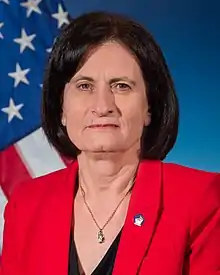Victoria Coleman
Victoria Stavridou-Coleman was the 22nd Director of the Defense Advanced Research Projects Agency (DARPA). She was the third woman to hold such a position since the agency's inception in 1958. She was appointed on the 31st of August 2020 and took her oath of office on the 24th of September 2020, administered by the Under Secretary of Defense for Research and Engineering, Michael Kratsios.[1][2][3][4][5] Victoria Coleman’s last day at the agency was Jan 20, 2021.[6]
Victoria Coleman | |
|---|---|
 | |
| 22nd Director of the Defense Advanced Research Projects Agency | |
| In office August 31, 2020 – January 20, 2021 | |
| President | Donald Trump |
| Preceded by | Steven H. Walker |
| Succeeded by | Peter Highnam (interim) |
Career
She has acted as a senior advisor to the Director of the Center for Information Technology Research in the Interest of Society (CITRIS) at UC Berkeley. In the past she held the position of CEO in Atlas AI, which is a public benefit corporation bringing world class AI solutions to sustainable development. Prior to Atlas AI she acted as the CTO of the Wikimedia Foundation, and had the responsibility for the technology infrastructure of Wikipedia. She has also acted as a Senior Vice President at Technicolor where she served as CTO of its Connected Home division. Prior to Technicolor she served as Senior Vice President R&D for Harman's Infotainment division. At Yahoo! as Vice President of Engineering she had the responsibility for membership services, presentation layer technologies, and developer relations. At Nokia as the Vice President of the Emerging Platforms she led a multi-disciplinary team with the aim of creating strategic products, which included the Nokia Z Launcher and the Nokia X line of smartphones. As the Vice President of the Software Engineering at HP Palm GBU she led the webOS Platform team and built the HP TouchPad. As the Vice President with Samsung's Advanced Institute of Technology in charge of the Computer Science Laboratory (San Jose, CA) she initiated the development of Tizen and the Samsung Knox line for smartphones. She was previously Intel's Director for Security Initiatives and the Director of the Trust and Manageability Laboratory in Intel's Corporate Technology Group. She joined SRI International in 1998 after 10 years as a tenured professor in the University of London. She became the founding Director of SRI's System Design Laboratory in 1999. She is also a former Defense Science Board member, the founding Chair of DARPA's Microsystems Exploratory Council, and an adviser to companies, including Lockheed Martin and Airbus.[2][3][4][5][7][8]
Early life
Victoria was born in Greece. She received a B.Sc in Electronic Computer Systems and a M.Sc in Computer Aided Logic Design from the University of Salford, and a Ph.D. in Computer Science from the University of Manchester. She holds four patents and is the author of more than 60 articles and books.[9]
References
- "Victoria Coleman Sworn In as 22nd DARPA Director". www.darpa.mil. U.S. Department of Defense - Defense Advanced Research Projects Agency. Retrieved 2020-12-03.
- "Department of Defense Announces New DARPA Director Dr. Victoria Coleman". U.S. DEPARTMENT OF DEFENSE. Retrieved 2020-12-03.
- "Dr. Victoria Coleman - DIRECTOR, DEFENSE ADVANCED RESEARCH PROJECTS AGENCY". www.darpa.mil. U.S. Department of Defense - Defense Advanced Research Projects Agency. Retrieved 2020-12-03.
- Cohen, Rachel S. (2020-11-20). "Meet New DARPA Director Victoria Coleman". Air Force Magazine. Retrieved 2020-12-03.
- GCT. "Greek-American Victoria Stavridou-Coleman Announced As New DARPA Director". Greek City Times. Retrieved 2020-12-03.
- "DARPA Changing Directors Again in Third Recent Shuffle". Air Force Magazine. 2021-01-22. Retrieved 2021-01-23.
- "Victoria Coleman". LinkedIn.
- "Victoria Coleman". The Rockefeller Foundation. Retrieved 2020-12-03.
- Barbara, Juliet (2016-11-02). "Wikimedia Foundation welcomes Victoria Coleman as Chief Technology Officer". Diff - Wikimedia Foundation. Retrieved 2020-12-03.